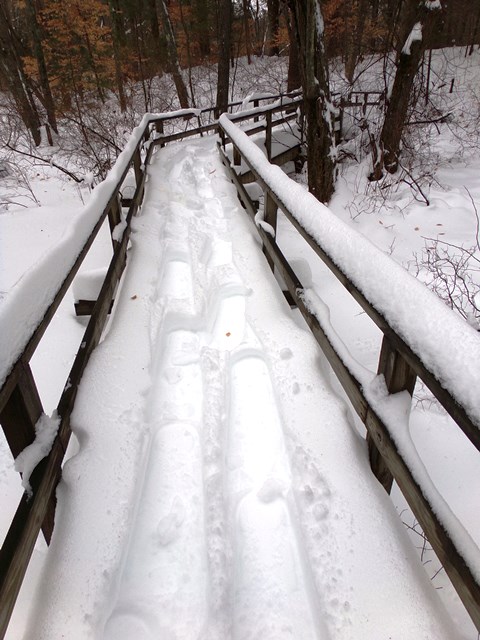We’ve just completed the second year of our Midwinter Bird Survey, a companion to our June Breeding Bird Circle Surveys. The winter counts take place at the same four points as the summer counts (on Sylvester Bridge, in the Old Field section of woods, in Woodchuck Field and on the small island in Jacobs Pond) and capture the picture of avian life here in the depth of winter.
This year’s counts were tough, weather-wise, and the results showed it. We had temperatures as low as 10 degrees with winds blowing 15 miles per hour. On the final count, we had four feet of snow on the ground, and we had to conduct the survey with snowshoes as seen above. The experience was an odd one; with snow as deep as it was, the top railing of the bridge came up to about our knees.
Results
On three days, counting from four points each day, we heard or saw 67 individual birds of 12 species. In 2014 we counted 305 individual birds of 16 species. 220 of those birds were Canada Geese in one flock of 110, counted in two separate circles, once sitting on Jacobs Pond, the second as a flyover group. Birds seen for the first time in 2015 included a Brown Creeper, Dark-eyed Juncos and Mute Swans; birds missing from the 2014 counts included American Crows, Golden-crowned Kinglets, Northern Cardinals, Red-bellied Woodpeckers, Ring-billed Gulls and Song Sparrows.
Frequency
The most frequently counted species (highest possible number being 12) were:
| Species |
2015 count |
Change |
| Black-capped Chickadee |
10 |
+2 |
| White-breasted Nuthatch |
6 |
-1 |
| Blue Jay |
5 |
+2 |
The following species that appeared in the “most frequently counted” list in 2014 dropped off in 2015:
| Species |
2015 count |
Change |
| American Robin |
2 |
-6 |
| Downy Woodpecker |
3 |
-3 |
| American Goldfinch |
4 |
-1 |
| Carolina Wren |
3 |
-2 |
Notes: Black-capped Chickadees are among the most widely distributed birds in the state, and were also the top two most frequently counted species in the 2014 Breeding Bird Circle counts. The dearth of any large woodpeckers (aside from a total of 1 Hairy Woodpecker), shows that these woods are still young. Bigger woodpeckers need bigger trees. SSNSC forest communities are still reforesting from the farming era.
Abundance
The most abundant birds (simply adding all individuals of a specific species throughout all circles, all days) were:
| Species |
2015 count |
Change |
| Black-capped Chickadee |
21 |
= |
| White-breasted Nuthatch |
8 |
-1 |
| American Goldfinch |
7 |
-4 |
The following species dropped off the “most abundant birds” list in 2015:
| Species |
2014 count |
Change |
| Canada Goose |
0 |
-222 |
| American Robin |
2 |
-10 |
| Carolina Wren |
3 |
-4 |
| Downy Woodpecker |
3 |
-3 |
Notes: The dearth of Canada Geese in 2015 was due to the fact that both the fields at Point 3 and the pond (Point 4) became inhospitable, the pond freezing over and the fields becoming covered with snow.
The single high count for any species was the lone encounter with 6 Dark-eyed Juncos at Point 1, which moved in a flock over the frozen vernal pool searching for food. The Mute Swan family of 4 moved on after the first count, having kept a small patch of water open briefly, but giving up on that effort when temperatures deeply plummeted. On two occasions I counted 4 Black-capped Chickadees in the same circle, and on one occasion I counted 4 American Goldfinches.
Other Sightings of Note
No other sightings of significance were made during these counts other than tracks. On January 17 we were the first people on the trails after a snowfall and came across both fox and fisher tracks on the bridges over the vernal pools.
Conclusions
The paucity of birds in total was due to weather, specifically to the heavy snowfall the blanketed the observation points. No ground scroungers had reason to be in the area, especially by the time of the third count, as approximately 4 feet of snow covered the ground, and therefore most of the seeds that had dropped from the bushes and trees were obscured. Secondarily, the freezing of Jacobs Pond forced out any waterfowl and gulls.
The resilience of the Black-capped Chickadee is worth noticing. Despite the conditions that obviously forced changes among many species, they held strong at the same abundance and increased the frequency with which they were recorded. Tufted Titmice, as predicted in 2014, made a small rebound, perhaps indicating that that year was a “down year” for the species hyper-locally. All of the birds sighted were appropriate for the time of year and the habitats.
The third SSNSC Winter Bird Circle Counts will commence around January 1, 2016.
